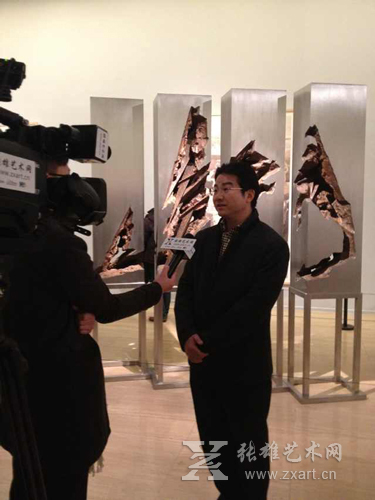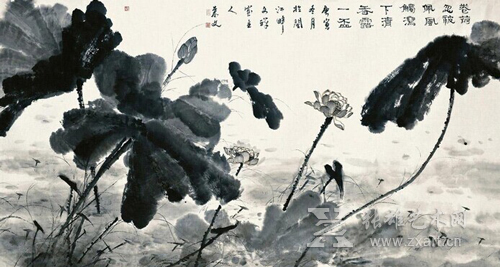Abstract:On December 16, 2014, the filming team of Zhang Xiong Art traveled to Beijing again to visit the famous contemporary flowers-and-birds painter Mr. Wang Laiwen. The “Four Gentlemen” plants: lofty plum, elegant orchid, upright and modest bamboo and adversities-fearless chrysanthemum have been the important components of traditional Chinese flowers-and-birds painting.

Zhang Xiong Art interviewing with the famous flowers-and-birds painter Wang Laiwen
Lofty plum,elegant orchid,upright and modest bamboo and adversities-fearless chrysanthemum are known as the “Four Gentlemen” plants in Chinese traditional painting. Since Song dynasty the “Four Gentlemen” have been the subjects of the traditional painting by the literati to express their praise for noble moral character and personality. But how about lotus? “ She grows in mud, yet never contaminates with it; she floats on waving water, yet never dances with it.” Her unearthly beauty and far-going pure and refreshing fragrance have made her an important “imagery” in the traditional culture. In this respect, painting lotus meant to be a great embodiment for new literati and artists to express their feelings.
On December 16, 2014, the filming team of Zhang Xiong Art traveled to Beijing again to visit the famous contemporary flowers-and-birds painter Mr. Wang Laiwen.

Wang Laiwen’s work
Wang Laiwen was born in end of 1960s in Zhangpu county of Fujian province which is also the hometown of Chinese calligraphy master Huang Daozhou. The place had a very good cultural atmosphere. Thus, Wang was well nourished with traditional cultural classics. In 1987, he was enrolled into the Department of Fine Art of Fujian Normal University. Fujian Normal University has a long history of over 100years. The Department of Fine Art was founded in 1941 by the scholar Mr.Xie Touba who used to study abroad in France. Famous flowers-and-birds painters such as Wu Fuzhi, Chen Zifen, and Song Shengyu used to teach there. After decades, it has developed its educational tradition of integrating Chinese and Western, ancient and modern and cultivating talents of expert in one field while possessing all-round knowledge and ability and become an influential art department in Fujian province and even in the southeast region. Wang received systematic art education there. During his four years in the university, he studied hard and was very good at thinking. No matter it was mountains-and-waters painting, figures painting or flowers-and-birds painting, no matter it was fine brushwork drawing or freehand brushwork drawing, he studied diligently and acquired solid basic skills. He was aware of the importance to study the tradition and classics for learning Chinese painting well. Therefore, he utilized his spare time to copy the Mustard Seed Garden painting book to practice his skills and study the essentials of ancient artists’ paintings and writings. In mid and late 1980s, a new wave of art movement swept the country. Many students were seeking for novelty and change and desired to become famous overnight. During such special time, Wang devoted himself to studying the tradition and won scholarships every year. He had kept an independent mind and showed outstanding potential. In 1991, Wang graduated from the Department of Fine Art of Fujian Normal University with the highest score.

Wang Laiwen’s work
In his artistic creation, Mr Wang Laiwen has fully taken the advantage of succinctness from the “eight mountain masters” and caught the essence of flowers- and-birds painting during Ming and Qing dynasties.
The plants of begonias, wisteria, orchid and cattail in his works all carries his sentiments. Every tree and bush in his hometown could be the subject of his creation. Over these years, Mr. Wang Laiwen even takes lotus as the main subject of his painting practices to express his own mood and sentiment.
The lines in Wang’s freehand painting of lotus can be forceful, or soothing, or light, or heavy yet all fascinating. The ink color is mainly light, but the chroma is well defined. Especially, his skill of painting the lotus leaves is ingenious, different from the common usage of “ink in five colors”. The colors of the ink all come out naturally from the brush. The whole painting appears refreshing, moist and refined.

Wang Laiwen’s work
Mr. Wang Laiwen said artists would feel the changes of flower blooming and withering with rich emotions; more and deeper you experience, richer your emotion and more touching the work under your brush would be. Without emotion, you could not create good work. Mr. Wang Laiwen respects the art with full piety from his heart and bones. He empties and cleans his heart to dialogue with ancients and nature to seek for noble and elegant spirit and virtuous art creation. With regard to the diverse painting styles of new literati nowadays and the values pursed by modern artists, does the integration of Chinese and western cultures and arts only bring the gap in time and space? Zhang Xiong Art will share more artistic views of famous modern artists with you.